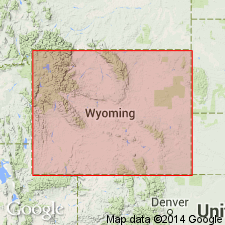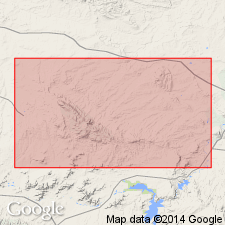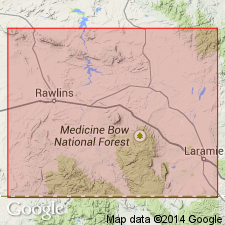
- Usage in publication:
-
- Wallace Creek tongue
- Modifications:
-
- Original reference
- AAPG geologic province:
-
- Wind River basin
Summary:
Pg. 141 (fig. 6), 142. Wallace Creek tongue of Cody shale. Name applied to lower of two transgressive marine sequences separating regressive sequences of the Mesaverde formation; previously called middle member of Mesaverde formation. Author assigns regressive marine sequences to the Mesaverde formation and transgressive marine sequences to the Cody shale. Overlies Phayles Reef member (new) and underlies an unnamed member, both of Mesaverde formation. Recognized in east-central Wyoming (Wind River basin); eastward into the Casper arch and Powder River basin, where the Phayles Reef intertongues with Steele shale, the Wallace Creek is indistinguishable from other parts of the Cody shale. Age is Late Cretaceous. Report includes cross sections.
Named on diagrammatic cross section of Mesaverde formation.
Source: US geologic names lexicon (USGS Bull. 1350, p. 804); supplemental information from GNU records (USGS DDS-6; Denver GNULEX).

- Usage in publication:
-
- Wallace Creek tongue
- Modifications:
-
- Overview
- Dominant lithology:
-
- Shale
- Sandstone
- Siltstone
- AAPG geologic province:
-
- Wind River basin
Summary:
Is a tongue of the Upper Cretaceous Cody shale that overlies Phayles member of Mesaverde formation and underlies the unnamed middle member of Mesaverde. Type section designated on northeast flank of Rattlesnake Hills in SW sec 4, T33N, R87W, Natrona Co, WY in the Wind River basin. Is 180 ft thick at type where it is composed mostly of gray, sandy to silty shale interbedded with buff to tan, poorly consolidated sandstone. Also has some thin, blocky-weathering, calcareous siltstone and gray to brown, highly calcareous, ledge-forming sandstone. Is less silty and sandy to east where Wallace Creek is predominantly gray clay shale. Pinches out at northwest end of Rattlesnake Hills. Thickens eastward. Merges eastward with upper part of Cody shale. Cross section. Of marine origin. Deposited in relatively shallow water during westward re-advance of Late Cretaceous sea. Some marine invertebrates. Correlated with upper part of Steele shale.
Source: GNU records (USGS DDS-6; Denver GNULEX).

- Usage in publication:
-
- Wallace Creek Tongue*
- Modifications:
-
- Overview
- AAPG geologic province:
-
- Wind River basin
Summary:
A distinctive unit assigned as an upper tongue of Cody Shale. Overlies Fales Sandstone Member (spelling changed; formerly "Phayles") of Mesaverde Formation. Underlies Parkman Sandstone Member of Mesaverde. Correlation chart. Is a transgressive marine unit equivalent to upper part of Haystack Mountains Formation (new) of Mesaverde Group. Of Late Cretaceous, late Campanian age.
Source: GNU records (USGS DDS-6; Denver GNULEX).
For more information, please contact Nancy Stamm, Geologic Names Committee Secretary.
Asterisk (*) indicates published by U.S. Geological Survey authors.
"No current usage" (†) implies that a name has been abandoned or has fallen into disuse. Former usage and, if known, replacement name given in parentheses ( ).
Slash (/) indicates name conflicts with nomenclatural guidelines (CSN, 1933; ACSN, 1961, 1970; NACSN, 1983, 2005, 2021). May be explained within brackets ([ ]).

